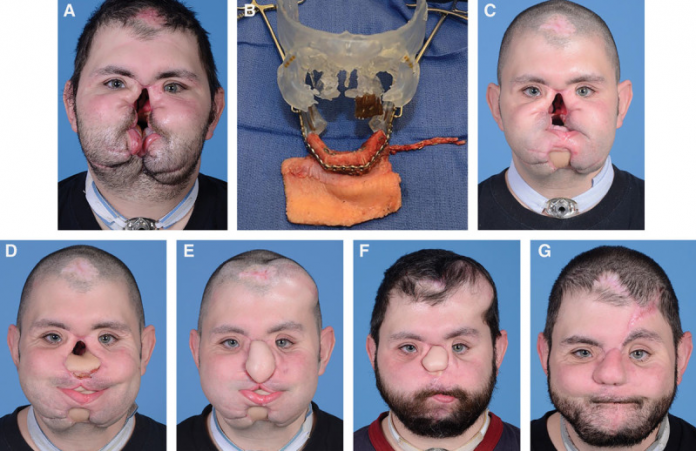
- Existing literature has shown that early and aggressive interventions of avulsive ballistic injuries improve outcomes.
- A 3-stage reconstructive algorithm advocates definitive and early reconstruction and optimises reconstructive outcomes of complex injuries.
- However, there is a need for further comparative studies.
A 36-year-old male patient was referred for facial transplant after an avulsive facial ballistic injury. The patient presented 7 months after the incident which caused composite tissue defects of the midface and lower face. Examination showed contracted soft-tissue envelope and a widening of the midface with loss of vertical facial tissue height.
Treatment plan
The treatment plan included use of CSP for mandibular reconstruction and a FOSC flap with intra- and extra-oral skin paddles. A second FOSC flap was used Moreover, during a subsequent procedure, skin paddles were used to resurface the nasal floor and palate. An ulnar forearm flap was used for grafting the nasal lining and costochondral rib for structural support.
Similarly, in preparation of a paramedian forehead flap, a tissue expander was placed in the left forehead. Additionally, the whistle deformity was corrected with a rotation-advancement upper lip repair. The external mandibular FOSC flap skin flap was deepithelialized and the skin of the chin bearing hair was advanced. Subsequently, dentoalveolar osseointegrated implants were also placed. For extra nasal surfacing, the paramedian forehead flap was used for tip/columella and sidewall support with additional costochondral grafting of the nasal dorsum.
Further planned procedures included minor tissue rearrangement and laser resurfacing to optimise cosmeisis.
References
Management of High-energy Avulsive Ballistic Facial Injury: A Review of the Literature and Algorithmic Approach https://www.ncbi.nlm.nih.gov/pmc/articles/PMC5908512/



